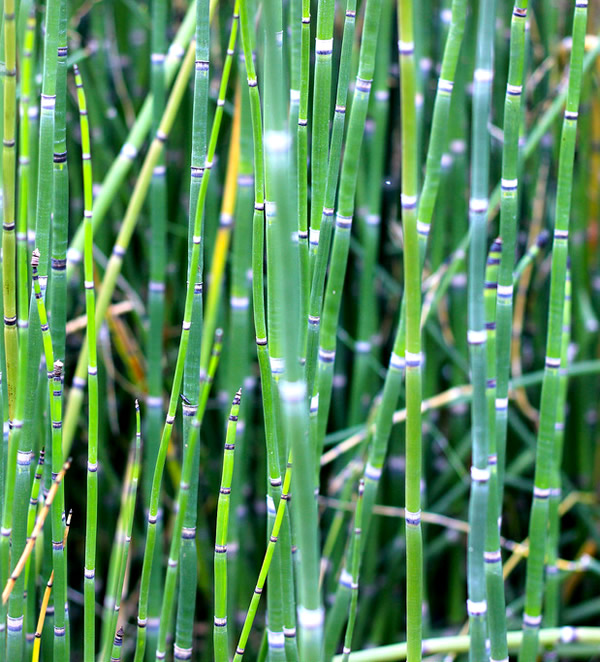 |
| Horsetails |
The plants known as horsetails or scouring rushes belong to the genus Equisetum, the only remaining genus in the phylum Sphenophyta, a group of seedless vascular plants.
Members of the phylum Sphenophyta, the horsetails, reached their maximum diversity during the Late Devonian and Carboniferous periods. One fossil group of the Sphenophyta, the calamites, grew from 12 to 18 meters (24 to 60 feet) in height, with trunks as much as 45 centimeters (more than 3 feet) in diameter.
Today these ancient plants survive in the single genus Equisetum. Equisetumis found throughout the world and, depending on the classification scheme, comprises between fifteen and twenty-five species.
  |
Species that have branching forms are commonly called horsetails; scouring rushes are the unbranched species. Equisetum prefers moist or wet habitats, although some species do grow in drier areas. They can often be found growing along streams and the edges of woodlands.
Appearance
The stems of Equisetum are distinctly ribbed, with obvious nodes and internodes; there are numerous stomata in the grooves beneath the ribs. While it is the stems that carry out photosynthesis, Equisetum does have true leaves. The scalelike leaves are found at the nodes and form a collar like structure just above the node. They are fused into a sheath around the stem.
Within the stems, especially of the scouring rushes, one can find significant deposits of silica, which gives the stems a rough, gritty texture. The name “scouring rush” indicates that, in a pinch, campers, like their pioneer forebears, can scrub dishes cleanwith stems of Equisetum.
American Indians used the abrasive stems to smooth and polish bows and arrows. Stems of some species have often been used in the manner of sandpaper to polish wood.
Across-section of a stem of Equisetum will show that the pith in the stem breaks down as the plant matures, leaving a hollow central canal in the stem. Two cylinders of smaller canals are located outside the pith.
The inner cylinders, called carinal canals, are associated with strands of xylem tissue, which conducts water, and strands of phloem tissue, which conducts the products of photosynthesis to places of storage. The outer cylinder contains vallecular canals, which contain air.
Reproduction
Asexual reproduction in Equisetum can take place through fragmentation of the stems, although sexual reproduction is the more common process. In the spring, some species produce, from the rhizomes, special cream- to buff-colored, nonphotosynthetic stems. Small, conelike strobili develop at the tips of these special stems or, in other species, at the tips of regular photosynthetic stems.
The strobili are usually about 2 to 4 centimeters (1 to 2 inches) long and look somewhat like little cones on top of the stems, with each conelike tip covered with hexagon-shaped plates. Each hexagon marks the top of a sporangiophore,which has five to ten elongate sporangia connected to the rim. When the sporangiophores separate slightly at maturity, the spores are released.
When the spore mother cells in the sporangia undergo meiosis, distinctive green spores are produced. The outer spore wall differentiates from the inside of the spore, forming coiled bands called elaters.
Elaters uncoil when they dry out, functioning like wings to carry the spore along in the wind. If the spores are blown into a moist habitat, the elaters coil up, allowing the spore to drop and land in habitat suitable for germination.
   |
After germination, spores produce lobed, cushion-like, photosynthetic green gametophytes that are seldom more than 8 millimeters in diameter but may range in size from a few millimeters up to 3.5 centimeters (about 1.5 inches) in diameter. Rhizoids anchor the gametophytes to the surface of the earth. The optimum habitats for gametophyte germination are recently flooded, nutrient-rich mudflats.
At first, about half of the gametophytes are male,with antheridia, and the other half are female, with archegonia. After a month or two, however, the female gametophytes of most species become bisexual, producing only antheridia.
When water contacts mature antheridia, sudden changes in water pressure cause the sperm cells produced within the antheridia to be explosively ejected. Sperm have several flagella, which aid themin swimming to the archegonia to fertilize the eggs. Several eggs on a female or bisexual gametophyte may be fertilized, and the development of more than one sporophyte is common.
Toxic Properties
Aerial stems develop from horizontal rhizomes, which are highly branched and perennial. Because the rhizomes can grow quite rapidly, Equisetum is often invasive.
 |
| Equisetum arvense |
If livestock pastures are invaded by Equisetum, it can cause problems for farmers and ranchers, as the aerial stems of Equisetum are poisonous. Equisetum arvense, a species found in the United States and southern Canada, is especially toxic in dry hay.
Horses, sheep, and cows are all susceptible to Equisetum poisoning. Symptoms include trembling, rapid pulse,weakness, excitability, diarrhea, staggering, and cold in the extremities. The major toxic substance is called thiaminase, which interferes with thiamine metabolism.
Medicinal Uses
Some members of the genus Equisetum have been found useful in folk and herbalmedicine. Both Equisetum arvense and Equisetum robustum are known to exert diuretic effects. Poultices of crushed sterile stems can be applied to wounds to stop bleeding. In Ukraine, decoctions of Equisetum heleocharis have been used for this purpose.
Boiling the stems yields a liquid extract that can be used as a mouthwash. There is a possibility that horsetail has some antibiotic properties. Roots were often given to teething babies, and Equisetum tea was often used to treat tubercular lung lesions.
